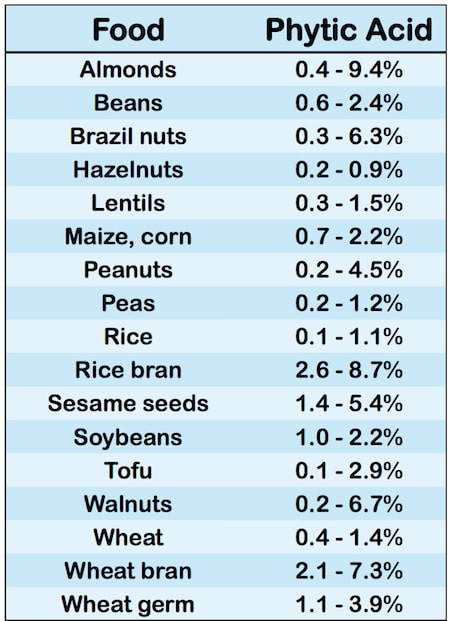Phytic acid is a unique natural
substance found in plant seeds.
It has received considerable attention
due to its effects on mineral absorption.
Phytic acid impairs the absorption of
iron, zinc and calcium, and may promote mineral deficiencies.
Therefore, it is often referred to as an
anti-nutrient.
However, the story is a bit more
complicated than that, because phytic acid also has a number of health
benefits.
This article takes a detailed look at
phytic acid and its overall effects on health.
Phytic acid, or phytate, is found in
plant seeds. It serves as the main storage form of phosphorus in the seeds.
When seeds sprout, phytate is degraded
and the phosphorus released for use by the young plant.
Phytic acid is also known as inositol
hexaphosphate, or IP6.
It is often used commercially as a
preservative due to its antioxidant properties.
BOTTOM LINE: Phytic acid is found in plant seeds, where it
serves as the main storage form of phosphorus.
Phytic acid is only found in
plant-derived foods.
All edible seeds, grains, legumes,
and nuts contain it in varying quantities, and small amounts are also found in
roots and tubers.
The
following table shows the amount contained in a few high-phytate foods, as a
percentage of dry weight:

As you can see, the phytic acid content
is highly variable. For example, the amount contained in almonds can vary up to
20-fold.
BOTTOM LINE: Phytic acid is found in all plant seeds, nuts,
legumes and grains. The amount contained in these foods is highly variable.
Phytic acid impairs absorption of iron
and zinc, and to a lesser extent calcium.
This applies to a single meal, not
overall nutrient absorption throughout the day.
In other words, phytic acid reduces
mineral absorption during the meal, but doesn't have any
effect on subsequent meals.
For example, snacking on nuts between
meals could reduce the amount of iron, zinc and calcium you absorb from the
nuts, but not from the meal you eat a few hours later.
However, when you eat high-phytate foods
with most of your meals, mineral deficiencies may develop over time.
In well balanced diets, this is rarely a
concern, but may be a significant problem during periods of malnutrition, and
in developing countries where the main food source is grains or legumes.
BOTTOM LINE: Phytic acid impairs the absorption of iron, zinc
and calcium. It may contribute to mineral deficiencies over time, but this is
rarely a problem with well-balanced diets.
Avoiding all foods that contain phytic
acid is a bad idea, because many of them (like almonds) are nutritious, healthy
and tasty.
Also, in many developing countries, food
is scarce and people need to rely on grains and legumes as their main dietary
staples.
Fortunately, several preparation methods
can significantly reduce the phytic acid content of foods.
Here
are the most commonly used methods:
·
Soaking: Cereals and legumes are often soaked in water
overnight to reduce their phytate content.
·
Sprouting: The sprouting of seeds, grains and legumes,
also known as germination, causes phytate degradation.
·
Fermentation: Organic acids, formed during fermentation,
promote phytate breakdown. Lactic acid fermentation is the preferred method, a
good example of which is the making of sourdough.
Combination of these methods can reduce
phytate content substantially.
For example, soaking, sprouting and
lactic acid fermentation can reduce the phytic acid content of quinoa
seeds by 98%.
In addition, sprouting and lactic acid
fermentation of white sorghum and maize may almost completely degrade the
phytic acid.
BOTTOM LINE: Several methods can be used to reduce the phytic
acid content of foods. This includes soaking, sprouting, and fermentation.
Phytic acid is a good example of a
nutrient that is both a "friend and foe", depending on the
circumstances.
In addition to its antioxidant
properties, phytic acid may be protective against kidney stones and cancer.
It has even been suggested that phytic
acid might be part of the reason whole grains may cut the risk of colon cancer.
BOTTOM LINE: Phytic acid may have several positive health
effects, acting against both kidney stones and cancer.
The short answer is, probably not.
However, those at risk of mineral
deficiency should diversify their diets and not include high-phytate foods in
all meals.
This is
particularly important among those who suffer from iron deficiency.
Vegetarians, especially vegans, are also
at risk.
The thing is, there are two kinds of
iron in foods; heme iron and non-heme iron.
Heme-iron is found in foods of animal
origin, such as meat, whereas non-heme iron comes from plants.
Non-heme iron from plant-derived foods
is poorly absorbed, while the absorption of heme-iron is efficient. Non-heme
iron is also highly affected by phytic acid, whereas heme-iron is not.
In addition, zinc is well absorbed from
meat, even in the presence of phytic acid.
Therefore, mineral deficiencies caused
by phytic acid are rarely a concern among meat-eaters.
However, phytic acid can be a
significant problem when diets are largely composed of high-phytate foods while
at the same time low in meat or other animal-derived foods.
This is of particular concern in many
developing nations where whole grain cereals and legumes are a large part of
the diet.
BOTTOM LINE: Phytic acid is usually not a concern in
industrialized nations, where food diversity and availability is adequate.
However, vegetarians/vegans and those who eat a lot of high-phytate foods may
be at risk.
High-phytate foods, such as grains,
nuts, and legumes, can raise the risk of iron and zinc deficiency.
As a countermeasure, strategies such as
soaking, sprouting and fermentation are often employed.
For those who eat meat regularly,
deficiencies caused by phytic acid are not a concern.
In fact, consumption of certain
high-phytate foods as part of a balanced, real food based diet has numerous
benefits.
In many cases, these benefits outweigh
any negative effects on mineral absorption.
No comments:
Post a Comment